Advanced Explanations For Kimi
The exact process used by Kimi to stimulate the pituitary gland into
producing more growth hormone and help you grow taller is very advanced.
The original research paper for Kimi's invention was more than 30 pages
long, full of pictures, diagrams, and terminologies. However, in order
to help you better understand the mechanisms, functionalities and
benefits of this great grow taller device, we simplified and organized
the professional research information into the following advanced
explanations for Kimi. To fully understand, you should carefully read
the following sections step by step (please do not skip any section).
After you finish reading you can understand the exact answers to the
following advanced questions about Kimi and growing taller in general:
Question 1:
What exactly is growth hormone and how does it affect human growth?
Question 2: What exactly is pituitary gland and how does it exactly
control the secretion of growth hormone?
Question 3: Why does NOT Kimi stimulate the exact nerve points directly
correspond to the pituitary gland (the spots under your big toes)?
Question 4: How exactly does the application of Kimi stimulate pituitary
gland into producing more growth hormone?
Question 5: Why is the application of Kimi different from taking any
form of artificial growth hormone directly?
Question 6: Why is the application of Kimi the most natural and
effective way to increase your growth hormone level?
Question 7: Why does the application of Kimi help you lose fat, gain
muscles, and grow taller at the same time?
Question 8: Why does the application of Kimi bring you dozens of
essential health benefits other than helping you grow taller?
Question 9: What are the differences between Kimi and all the other
height increasing programs?
Question 10: Why can you benefit from the application of Kimi regardless
of your age?
Ready to learn the truth about human growth? O.K., let's begin!
Endocrine System - The Big Picture
You Should Look At First
When we talk about human growth, most people only know that pituitary
gland is the master of growth. But actually
pituitary gland is only a small part of a
complex system inside of your body - the Endocrine System.
Just like your heart can only work inside of your chest, pituitary gland
can only function in the context of this system. The endocrine
system is made up of specialized cells, glands and hormones. Acting like
a communication network, endocrine system responds to stimuli
by releasing hormones, the chemical messengers that
carry instructions from endocrine glands to target cells
throughout the body. The target cells read and follow the hormones'
instructions, sometimes building a protein or releasing another hormone.
These actions lead to many bodily responses such as a faster heart beat
or muscle and bone growth. Glands are functional units of hormone secreting cells located in various regions of the body
making up the endocrine system. Each gland has specific functions
that help to maintain the normal internal environment and promote the
survival of the organism. Although there are some diffuse endocrine
tissues, as in the gastrointestinal epithelium, there are several
major control centers or glands within the endocrine system,
including: hypothalamus, pituitary gland, adrenal gland, thyroid,
parathyroid, pancreas, testes, ovary, and pineal (see the illustration
below). Out of these endocrine glands, the ones which control or
regulate human growth are hypothalamus, pituitary gland, adrenal gland and pancreas. In addition to these
glands, another important organ - liver, also plays a significant
role in facilitating the growth process.
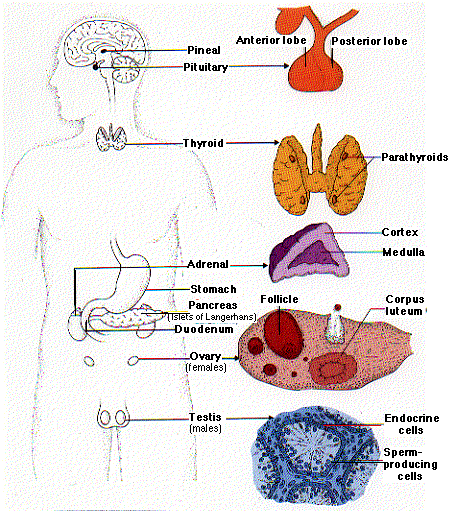
Functional Anatomy of the
Hypothalamus and Pituitary Gland
The hypothalamus is a region of the brain that
controls an immense number of bodily functions. It is
located in the middle of the base of the brain, and encapsulates the
ventral portion of the third ventricle.
The pituitary gland, also known as the hypophysis, is a
roundish organ that lies immediately beneath the
hypothalamus, resting in a depression of the base of the skull
called the sella turcica ("Turkish saddle"). In an adult human, the
pituitary is roughly the size and shape of a garbonzo bean.
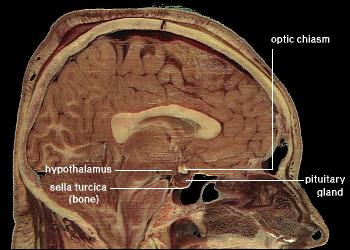
The above image shows these anatomical relationships between
hypothalamus and pituitary gland.
Careful examination of the pituitary gland reveals that it composed of two distinctive parts:
|
The anterior pituitary (adenohypophysis) is a classical gland
composed predominantly of cells that secrete protein hormones.
The posterior pituitary (neurohypophysis) is not really an
organ, but an extension of the hypothalamus. It is composed largely
of the axons of hypothalamic neurons which extend downward as a
large bundle behind the anterior pituitary. It also forms the
so-called pituitary stalk, which appears to suspend the
anterior gland from the hypothalamus.
The image on the right shows a frontal view of a sheep pituitary
gland and hypothalamus. The posterior gland can be seen peeking out
behind the anterior gland.
The anterior and posterior pituitary have separate embryological
origins. In many mammals, there is also an intermediate lobe (pars
intermedia) between the anterior and posterior pituitary. |
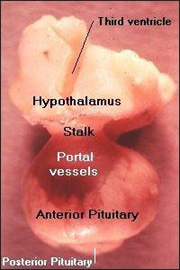 |
A key to understanding the endocrine relationship
between hypothalamus and anterior pituitary is
to appreciate the vascular connections between these
organs. As we will emphasized a little later, secretion of hormones from the anterior pituitary is under strict control by hypothalamic hormones. These hypothalamic hormones reach
the anterior pituitary through the following route:
-
A branch of the hypophyseal artery ramifies into a capillary bed in
the lower hypothalamus, and hypothalmic hormones destined for the
anterior pituitary are secreted into that capillary blood.
-
Blood from those capillaries drains into hypothalamic-hypophyseal
portal veins. Portal veins are defined as veins between two
capillary beds; the hypothalamic-hypophyseal portal veins branch again
into another series of capillaries within the anterior pituitary.
-
Capillaries within the anterior pituitary, which carry hormones
secreted by that gland, coalesce into veins that drain into the
systemic venous blood. Those veins also collect capillary blood from
the posterior pituitary gland.
This pattern of vascular connections is presented in the diagram below.
Note also the hypothalamic-hypophyseal portal vessels in the image of a
real pituitary gland seen above.
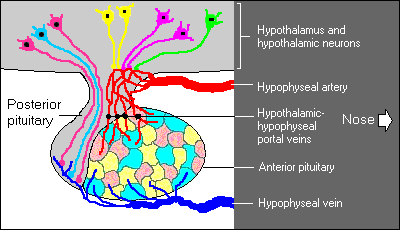
The utility of this unconventional vascular system is that minute
quantities of hypothalamic hormones are carried in a
concentrated form directly to their target cells in
the anterior pituitary, and are NOT diluted out in the
systemic circulation.
Overview of Hypothalamic and Pituitary Hormones
The pituitary gland is often portrayed as the master gland
of the body. Such praise is justified in the sense that the anterior
and posterior pituitary secrete a battery of hormones
that collectively influence all cells and affect
virtually all physiologic processes.
|
The pituitary gland may be the king, but the power behind the throne is actually the
hypothalamus. As mentioned before, some of the neurons within the hypothalamus - neurosecretory neurons -
secrete hormones that strictly control secretion of
hormones from the anterior pituitary. The hypothalamic
hormones are referred to as releasing hormones and
inhibiting hormones, reflecting their influence on anterior
pituitary hormones.
Hypothalamic releasing and inhibiting hormones are
carried directly to the anterior pituitary gland
via hypothalamic- hypophyseal portal veins. Specific
hypothalamic hormones bind to receptors on specific
anterior pituitary cells, stimulating or inhibiting the
release of the hormone they produce (as
illustrated in the image on the right). |
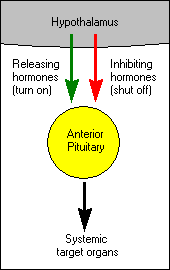
|
The following table summarizes the major hormones synthesized and
secreted by the hypothalamus and pituitary gland, along
with summary statements about their major functions and
corresponding regulators.
Hypothalamus
Hormone
Released |
Hormone Structure |
Hormone Function |
Hormone
Regulator |
|
Hypothalamic Releasing Hormones |
Peptides |
Acts on the anterior lobe of the pituitary gland to stimulate
the release of certain pituitary hormones. |
Blood Levels of Specific Substances |
|
Hypothalamic Inhibiting Hormones |
Peptides |
Acts on the anterior lobe of the pituitary gland to inhibit
the release of certain pituitary hormones. |
Blood Levels of Specific Substances |
Pituitary Gland
|
|
Hormone
Released |
Hormone Structure |
Hormone
Function |
Hormone
Regulator |
Anterior
Pituitary |
Growth Hormone
(GH) |
Protein |
Stimulates muscle and bone growth; Promotes protein synthesis and
fat mobilization. |
Hypothalamic Hormones |
|
Prolactin |
Protein |
Promotes production and secretion of milk in humans after
childbirth. |
Hypothalamic Hormones |
|
Thryoid-Stimulating Hormone (TSH) |
Glycoprotein |
Stimulates production and secretion of thyroid hormones. |
Blood Thyroxine Levels; Hypothalamic Hormones |
|
Adrenocorticotropic Hormone (ACTH) |
Polypeptide |
Stimulates adrenal cortex to secrete cortisol and other steroids. |
Corticotropin-Releasing Hormone (CRH) from the Hypothalamus; Blood
Cortisol Levels |
|
Posterior
Pituitary
|
Antidiuretic Hormone |
Peptide |
Increases water absorption from kidney; Raises blood pressure. |
Blood Osmolarity |
|
Oxytocin |
Peptide |
Stimulates contraction of pregnant uterus & release of breast milk
after childbirth. |
Nervous System |
As seen in the table above, the anterior pituitary synthesizes and
secretes 6 major hormones, among these growth hormone is the
most important one to us because it directly regulates
our muscle and bone growth.
Physiologic Effects of Growth Hormone
Growth hormone (as illustrated in the image below) is also known
as somatotropin. It is a protein hormone of 191 amino acids
that is synthesized and secreted by cells called somatotrophs in the
anterior pituitary. It is a major participant in control of
several complex physiologic processes, including
muscles and bone growth.
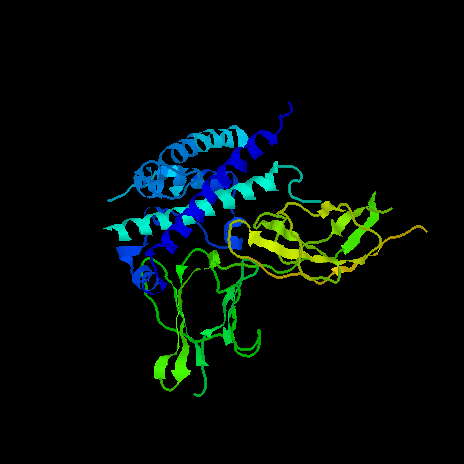
A critical concept in understanding growth hormone activity
is that it has two distinct types of effects (as
illustrated in the below):
-
Direct effects are the result of growth hormone binding
its receptor on target cells. Fat cells (adipocytes),
for example, have growth hormone receptors, and growth hormone
stimulates them to break down triglyceride and supresses their
ability to take up and accumulate circulating lipids.
-
Indirect effects are mediated primarily by an insulin-like growth factor-1 (IGF-1), a hormone that
is secreted from the liver and other tissues in response
to growth hormone. A majority of the growth
promoting effects of growth hormone is actually due to
IGF-1 acting on its target cells.
|
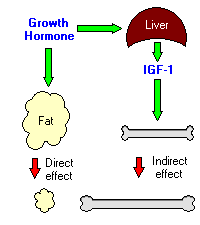 |
Keeping this distinction in mind, we can conclude two major roles
of growth hormone and its byproduct IGF-1 in physiology:
-
Effects on muscle and bone Growth. Growth is a very complex
process, and requires the coordinated action of several
hormones. The major role of growth hormone in stimulating body growth
is to stimulate the liver and other tissues to secrete IGF-1.
IGF-1 is the key player in muscle growth. It stimulates both the
differentiation and proliferation of myoblasts (muscle cells). It also
stimulates amino acid uptake and protein synthesis in muscle and other
tissues. Moreover, IGF-1 stimulates proliferation of chondrocytes
(cartilage cells), resulting in bone growth. So Growth
hormone has a direct effect on bone growth by stimulating
differentiation of chondrocytes.
-
Metabolic Effects. Growth hormone has important effects on
protein, lipid and carbohydrate metabolism. In some cases, a
direct effect of growth hormone has been clearly demonstrated, in
others, IGF-1 is thought to be the critical mediator, and some cases
it appears that both direct and indirect
effects are at play.
-
Carbohydrate metabolism: Growth hormone is one of a battery
of hormones that serves to maintain blood glucose within
a normal range. Growth hormone is often said to have
anti-insulin activity, because it suppresses the abilities of
insulin to stimulate uptake of glucose in peripheral tissues and
enhance glucose synthesis in the liver.
-
Protein metabolism: In general, growth hormone stimulates
protein anabolism in many tissues. This effect reflects increased
amino acid uptake, increased protein synthesis and
decreased oxidation of proteins.
-
Fat metabolism: Growth hormone enhances the
utilization of fat by stimulating triglyceride breakdown and
oxidation in adipocytes.
The amount of growth hormone in your blood determines the
speed and easiness to convert digested food into energy and
utilize it. Therefore, growth hormone is the most important substance to keep your weight at a desirable level.
Teenagers naturally produce much more growth hormone than middle aged
people, so they can still stay fit even they eat lots of food. In the
contrast, people who lack growth hormone (older people) will tend to
gain weight by just consuming a little food.
The following image is a visual summary of the important points we have
covered so far: the relationship between hypothalamus and pituitary
gland, as well as the functions of growth hormone and IGF-1.
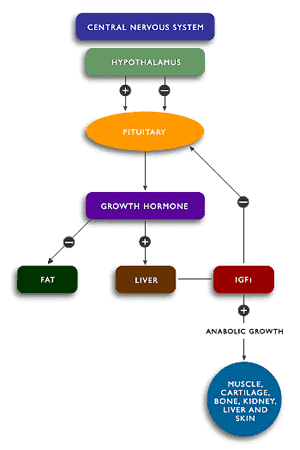
Negative Feedback Circuit Controls
Growth Hormone Secretion
Production of growth hormone is primarily
controlled by a mechanism called Negative Feedback Circuit
(although it can also be affected by other factors including stress,
exercise, nutrition, and sleep).
Feedback circuits are at the root of most control mechanisms in
physiology, and are particularly prominent in the endocrine system.
Instances of positive feedback certainly occur, but negative feedback is
much more common. Negative feedback is seen when the output of a
pathway inhibits inputs to the pathway. The heating system in
your home is a simple Negative Feedback Circuit. When the furnace
produces enough heat to elevate temperature above the set point of the
thermostat, the thermostat is triggered and shuts off the furnace (heat
is feeding back negatively on the source of heat). When temperature
drops back below the set point, negative feedback is gone, and the
furnace comes back on.
In our case Negative Feedback Circuit is used extensively
to regulate secretion of growth hormone. As mentioned above, the
release of growth hormone by pituitary gland is actually controlled by
hypothalamus. More accurately, two hypothalamic hormones
ultimately control all the production of growth
hormone:
-
Growth hormone-releasing hormone (GHRH) is a peptide that
stimulates both the synthesis and secretion of growth hormone.
-
Somatostatin (SS) is a peptide produced by several tissues in
the body, including the hypothalamus. Somatostatin inhibits growth
hormone release in response to GHRH and to other stimulatory factors
such as low blood glucose concentration.
The Negative Feedback Circuit uses these two hypothalamic
hormones to control the secretion of growth hormone. The
basic mechanisms for the negative feedback control in this system
(as illustrated in the image on the right) are:
-
GHRH (Growth Hormone Releasing Hormone) secreting neurons in the
hypothalamus detect the low blood concentration of
growth hormone and Insulin-like Growth Factor-1 (IGF-1), and in a
response these neurons secrete GHRH, which is then carried
directly to the anterior pituitary gland via hypothalamic-
hypophyseal portal veins. Once arrived at anterior pituitary
gland, GHRH stimulates the activities of somatotrophs (cells which
secrete growth hormone) so these cells start releasing
growth hormone.
-
Released growth hormone binds to receptors on
targeted cells in the body, promoting carbohydrate metabolism,
protein synthesis and fat mobilization. Growth hormone also
stimulates the liver and other tissues to secrete Insulin-like
Growth Factor-1 (IGF-1). IGF-1 in turn acts on its target
cells, i.e., chondrocytes (cartilage cells) and myoblasts
(precursors of muscle cells) to stimulate muscle and
bone growth.
-
Increasing growth hormone level soon negatively
feeds back to inhibit GHRH secretion. When blood
concentration of growth hormone increases above a
certain threshold, GHRH-secreting neurons in the
hypothalamus are inhibited and stop secreting GHRH, while SS-secreting neurons in the hypothalamus are stimulated
and start secreting SS, which is then carried directly to
the anterior pituitary gland via hypothalamic- hypophyseal portal
veins. Once arrived at anterior pituitary gland, SS inhibits
the activities of somatotrophs (cells which secrete growth
hormone) so these cells stop releasing growth hormone.
Growth hormone's byproduct - IGF1 also triggers the
Negative Feedback Circuit. Increased growth hormone level
stimulates liver to secrete IGF-1. High blood levels of
IGF-1 not only stimulates the release of SS from the
hypothalamus, but also by directly suppresses the
somatotrophs in the pituitary gland. The combined effect is
the immediate turn-off of growth hormone secretion.
-
As growth hormone levels decrease below the
threshold, negative feedback is relieved, GHRH
secretion starts again, leading to growth hormone secretion... and
the circle restarts again.
|
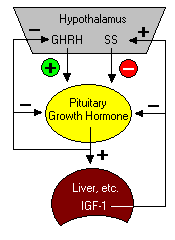 |
Integration of all the factors that affect growth hormone synthesis and
secretion lead to a pulsatile pattern of release. The natural
concentration of growth hormone in blood are very low,
because usually the body only secrets growth hormone up to a
level to maintain homeostasis and once a steady
state is achieved growth hormone secretion is stopped
by the Negative Feedback Circuit. Therefore, the only effective way to
increase the secretion of growth hormone is to minimize the
effect of the Negative Feedback Circuit by creating a
natural Positive Feedback Circuit.
The Application of Kimi Creates A Natural
Positive Feedback Circuit To Stimulate
Growth Hormone Secretion
Positive feedback is seen when the output of a pathway
stimulates inputs to the pathway. An example of positive feedback is
the phenomenon of autacatalysis, which occurs in some digestive enzymes
such as pepsin. Pepsin is a protein-digesting enzyme that works in the
stomach. However, the stomach does not secrete pepsin; it secretes an
inactive form, called pepsinogen. When one pepsinogen molecule becomes
activated, it helps to activate other pepsinogens nearby, which in turn
can activate others. In this way, the number of active pepsin molecules
can increase rapidly, by using positive feedback.
In your case, you need a Positive Feedback Circuit that minimizes
the effect of your body's Negative Feedback Circuit and
maximizes your pituitary gland's secretion of growth hormone.
Here is where our great Kimi device comes to serve
you: the application of Kimi will create a natural Positive Feedback Circuit by stimulating the activities
of Adrenal gland, Pancreas, and liver.
Kimi actually uses the same principle as the famous
Chinese acupuncture, which is called reflexology. Your
feet can be seen as mirror images of your body. The
following picture on the left is a quick look at how your body
matches to the sole of your feet. Notice how the shape
and curve of your feet match the shape and curve
of your body. The following picture on the right shows that the
spinal column is reflected in the inside curve of the
foot. Studies have shown that the curve of an individual's foot matches
the curve of his/ her spinal column with mathematical precision.
Have a look at your own foot and those around you!
Stimulation in any part of your feet mirrors in
turn will stimulate the corresponding part of the body.
Reflexology is the application of pressure, movement, and stimulation to
your feet to affect corresponding parts of your body. Pressure applied to the feet generates a signal through the peripheral nervous system. From there it enters the
central nervous system where it is processed in various parts of the
brain. It is then relayed to the internal glands and organs
to stimulate the necessary adjustments in their activities
and functions.
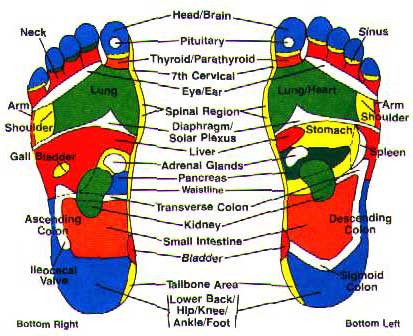
Before you use Kimi, you place the most convex parts of the
stimulator device against the most concave parts of your feet. Referring
to the foot reflexology chart above, the nerve points corresponding to
your adrenal gland, pancreas, and livers locate at the most concave
parts of your feet. When you walk with Kimi, Kimi applies the principle of reflexology: the convex parts
of the device constantly stimulate the nerve points corresponding to your adrenal gland, pancreas, and livers, thus in turn stimulate the activities of these important
glands and organ to create a natural Positive Feedback Circuit to
increase growth hormone secretion. The detailed mechanisms used to
create the Positive Feedback Circuit are explained below.
|
Firstly, the application of Kimi stimulates adrenal gland to increase metabolism, while decrease glucose (major
form of sugar) and
insulin levels in blood. Adrenal gland (as
illustrated in the image on the right), which are also called
suprarenal glands, are small, triangular glands located on top of
both kidneys. An adrenal gland is made of two parts: the outer
region is called the adrenal cortex and the center region is called
the adrenal medulla. The adrenal cortex produces hormones necessary
for fluid and electrolyte (salt) balance in the body such as
cortisone and aldosterone, which are not within our concern.
However, the adrenal medulla, if under stimulation, produce two very
important hormones: epinephrine and norepinephrine, which increase
the heart rate and force of heart contractions, facilitates blood
flow to the muscles and brain, assists in pulmonary ventilation
(better breathing), increase overall metabolism rate, and most
importantly, decrease blood concentrations of glucose and
insulin.
Insulin (as illustrated in the image on the right) is a small
protein containing 51 amino acids. Insulin is secreted by pancreas in response to high blood concentrations of glucose.
Glucose (major form of sugar) is liberated from dietary carbohydrate
such as starch or sucrose by hydrolysis within the small intestine,
and is then absorbed into the blood. High concentrations of glucose
in blood stimulate release of insulin, and insulin acts on cells
throughout the body to stimulate uptake, utilization and storage of
glucose. If the blood concentrations of glucose are low, little or
no insulin will be secreted. Thus by stimulating the adrenal gland,
the application of Kimi increases the overall metabolism and decreases the insulin levels in the blood. |
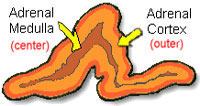
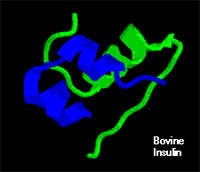 |
An increased metabolism helps create a Positive Feedback Circuit
to increase the secretion of growth hormone because the
existing growth hormone in the blood can be quickly
carried to its targeted cells and used up to grow
muscle and bone. This will decrease the blood concentration
of growth hormone and thus trigger neurons in the hypothalamus to
secrete GHRH that stimulates pituitary gland into secreting more growth
hormone. A decreased blood concentration of insulin also
helps create a Positive Feedback Circuit because insulin is the
biggest inhibitor for growth hormone's secretion. Recall an
important point in the above section of the Negative Feedback Circuit:
besides growth hormone itself, its byproduct, Insulin-like Growth
Factor-1 (IGF-1) also triggers the Negative Feedback Circuit to
inhibit the secretion of growth hormone. Insulin-like Growth
Factor-1 (IGF-1), as the name suggests, are structurally very
similar to the insulin molecule. Essentially an IGF-1 is about two
thirds of an insulin. Since they are almost the same, high blood
concentrations of insulin has essentially the same
effect as high blood concentrations of IGF-1 - to
inhibit the secretion of growth hormone! Therefore, by decreasing
the blood concentrations of both growth hormone and insulin, the
application of Kimi removes the two main causes
that trigger the Negative Feedback Circuit, and starts a Positive
Feedback Circuit that leads to increase the secretion of growth
hormone.
|
Secondly, the application of Kimi stimulates pancreas
to secrete glucagon and further enhances the
Positive Feedback to increase the secretion of growth hormone. The pancreas (as illustrated in the image on the right) houses
two distinctly different tissues. The bulk of its mass is exocrine
tissue and associated ducts, which produce an alkaline fluid loaded
with digestive enzymes which is delivered to the small intestine to
facilitate digestion of foodstuffs and has little to do with the
secretion of growth hormone. Scattered throughout the exocrine
tissue are several hundred thousand clusters of endocrine cells
which produce the hormones insulin and glucagon. |
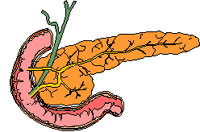 |
Glucagon (as illustrated in the left image below) is a linear peptide of
29 amino acids which has the opposite effect of insulin. That is,
glucagon has the effect of increasing blood glucose levels.
Knowing that glucagon's major effect is to increase blood glucose
levels, it makes sense that glucagon is secreted in response to low
blood concentrations of glucose. Although pancreas secretes both insulin
and glucagon, it can not secrete both of them at the same time. Exactly
which hormone is secreted by pancreas at a certain time is determined by
the blood concentrations of glucose. When the blood concentrations of
glucose are high, the pancreas secretes insulin; when the blood
concentrations of glucose are low, the pancreas secretes glucagon (as
illustrated in the right image below). Since the stimulation of adrenal
gland has caused low blood concentrations of glucose, pancreas secretes
glucagon when it is also stimulated by Kimi. In contrast to
insulin, glucagon is a stimulator for the secretion of
growth hormone. Therefore, by stimulating pancreas to secrete more
glucagon, the application of Kimi further enhances the Positive
Feedback Circuit that increases the secretion of growth hormone.
Finally, the application of Kimi stimulates liver to
secrete IGF-1 in response to the extra growth hormone secreted by
the pituitary gland and induce another cycle of the Positive
Feedback Circuit. Growth hormone binds to cells in the liver, and these
cells release IGF-1 into the blood. Increased metabolic rate and blood circulation resulted from stimulating the adrenal gland
carry IGF-1 to its targeted cells and stimulate muscle
and bone growth. This in return decreases blood
concentration of growth hormone and IGF-1, thus completing a circle of the Positive Feedback Circuit. Then the process returns to step
one, where low blood concentration of growth hormone and IGF-1 further trigger another positive feedback and signal hypothalamic to
release more GHRH that stimulates pituitary gland to secrete
even more growth hormone. The Positive Feedback Circuit will
continue like this as long as you keep using Kimi
to stimulate the activities of adrenal gland, pancreas, and liver.
Moreover, such Positive Feedback Circuit is completely natural
and safe since the extra growth hormone and IGF-1 are
immediately transported to their targeted cells and
consumed in stimulating muscle and bone growth. After you stop using Kimi, the Positive Feedback Circuit is interrupted and your
body's Negative Feedback Circuit will soon stop the extra secretion of
growth hormone.
Answers to All the Advanced Questions
After reading all of the above advanced explanations, you should
be able to understand the answers to the following advanced questions.
Question 1: What exactly is growth hormone and how does it
affect human growth?
Answer: Growth hormone, also known
as somatotropin, is a protein hormone of 191 amino acids that is
synthesized and secreted by cells called somatotrophs in the anterior
pituitary. Growth hormone facilitates metabolism and controls
muscle and bone growth.
Question 2: What exactly is pituitary gland and how does it
exactly control the secretion of growth hormone?
Answer: Pituitary gland is a small
gland located at the base of the brain. It consists of two different
lobes - anterior and posterior pituitary. Its anterior pituitary
produces numerous hormones, including the most important growth hormone.
Nevertheless, pituitary gland can not be seen as the master gland of the
endocrine system, because its activities are directly
controlled by a region of the brain called hypothalamus. So
strictly speaking, it is not pituitary gland, but hypothalamus which
controls the secretion of growth hormone. By detecting the
blood concentrations of growth hormone and Insulin-like
Growth Factor-1 (IGF-1), hypothalamus secretes Growth Hormone
Releasing Hormone (GHRH) or Somatostatin (SS) to stimulate or
inhibit pituitary gland's activities of producing growth hormone.
The blood concentrations of growth hormone and IGF-1 are in turn regulated by a mechanism called Negative Feedback Circuit
in your body: when there is little growth hormone or IGF-1 present in
blood, hypothalamus stimulates pituitary gland to secrete some growth
hormone; but as soon as the growth hormone level raises a little higher,
hypothalamus inhibits pituitary gland to secrete any more growth
hormone. In short the pituitary gland only secrets growth hormone up to a level to maintain homeostasis because once
a steady state is achieved growth hormone secretion is
stopped by the Negative Feedback Circuit.
Question 3: Why does NOT Kimi stimulate the exact
nerve points directly correspond to the pituitary
gland (the spots under your big toes)?
Answer: This should be very clear
right now: it is hypothalamus, not pituitary gland that actually
controls the secretion of growth hormone, so directly stimulating
pituitary gland would have little result on increasing the growth
hormone secretion. Moreover, hypothalamus only responds to
the blood concentration of the growth hormone and IGF-1,
which is strictly regulated by the Negative Feedback Circuit. The
only effective way to increase the secretion of growth hormone is to minimize the effect of the Negative Feedback Circuit by
creating a natural Positive Feedback Circuit, so the blood
concentrations of growth hormone and IGF-1 stay low even when extra amount of growth hormone is secreted by the pituitary
gland. As aforementioned, the application of Kimi will create
such a natural Positive Feedback Circuit by stimulating the activities
of adrenal gland, pancreas, and liver. And because the nerve
points corresponding to adrenal gland, pancreas, and liver locate at the most concave parts of your feet, Kimi stimulates these
parts of your feet instead of the spots under your big toes.
Question 4: How exactly does the application of Kimi stimulate
pituitary gland into producing more growth hormone?
The application of Kimi stimulates the activities
of adrenal gland, pancreas, and liver to create a
natural Positive Feedback Circuit, which minimizes the effect of
the Negative Feedback Circuit so the blood concentrations of
growth hormone and IGF-1 stay low even after pituitary
gland secrets extra amount of growth hormone. The constant low
blood concentrations of growth hormone and IGF-1 cause hypothalamus to keep secreting Growth Hormone Releasing Hormone (GHRH) which
stimulates pituitary gland to keep secreting growth hormone. The
Positive Feedback Circuit also increases the metabolism
so the extra amount of growth hormone and its byproduct IGF-1 are
immediately transported to their targeted cells and
used up in stimulating muscle and bone growth. For
more detailed explanation on how does Kimi work, read the above
section named "The Application of Kimi Creates A Natural Positive
Feedback Circuit to Stimulate Growth Hormone Secrtion".
Question 5: Why is the application of Kimi different from
taking any form of artificial growth hormone directly?
Answer: By now you should understand
that the secretion of growth hormone is mainly controlled by the
Negative Feedback Circuit, and the only effective way to increase
the secretion of growth hormone is to minimize the effect of the
Negative Feedback Circuit by creating a natural Positive Feedback
Circuit. Taking any form of artificial growth hormone
can only make the Negative Feedback Circuit in your body much worse. The presence of artificial growth hormone in your
blood will immediately trigger the Negative Feedback Circuit to
terminate your natural secretion of growth hormone. On the
other hand, your metabolism is NOT increased and can
NOT catch up the quick build-up of artificial growth hormone,
so your body can NOT transport or utilize this "outside"
growth hormone effectively. It may quickly end up with large amount
of artificial growth hormone accumulating at inappropriate
parts of your body and cause all kinds of serious
side effects such as negative metabolic effects, hip disease, pancreatitis, and even leukemia (a disease in which the body produces
too many white blood cells, causing weakness and sometimes leading to
cancer and death). Even worse, if you take artificial growth hormone for
a prolonged period, your hypothalamus will become insensitive
to blood concentrations and weaken or even lose the ability of
stimulating pituitary gland to secrete natural growth hormone even
after you stop taking artificial growth hormone. So taking
artificial growth hormone is disruptive and dangerous. In contrast, the application of Kimi is very effective in creating a Positive Feedback
Circuit which minimizes the effect of the Negative Feedback
Circuit and increases the secretion of your natural growth
hormone. The application of Kimi also significantly
increases your metabolism rate so the extra amount of
growth hormone and its byproduct IGF-1 are immediately
transported to their targeted cells and used up in
stimulating your muscle and bone growth. After you stop
using Kimi, the Positive Feedback Circuit is interrupted
and your body's Negative Feedback Circuit will soon stop the
extra secretion of growth hormone so there will NEVER be any
extra growth hormone flowing around in the wrong parts of your body.
Such effectiveness and safety measure makes the
application of Kimi totally different from taking
any form of artificial growth hormone directly.
Question 6: Why is the application of Kimi the most natural
and effective way to increase your growth hormone level?
Answer: Similar to the answer to
Question 5 above, the application of Kimi creates a
natural Positive Feedback Circuit to increase the
natural secretion of growth hormone; it also increase
your metabolism to transport and utilize extra
amount of growth hormone so your body can enjoy the benefits of growth hormone (muscle and bone growth) while
avoid any side effect at the same time.
Question 7: Why does the application of Kimi help you lose fat, gain muscles, and grow taller at the same time?
Answer: So far you must have known
that using Kimi is the best way to help you increase your growth
hormone level effectively and safely. The extra growth hormone induced
by the application of Kimi has two major
physiologic effects: stimulates fat cells (adipocytes) to break
down fatty acid (triglyceride) and suppresses their ability to take
up and accumulate circulating lipids, as well as stimulates muscle
and bone growth. Obviously, the two effects are achieved at the same time: the first effect helps you lose fat and gain muscles, the second effect helps you grow taller.
Thus the application of Kimi helps you lose fat, gain muscles,
and grow taller at the same time.
Question 8: Why does the application of Kimi bring you dozens of essential health benefits other than helping you
grow taller?
Answer: Besides stimulating adrenal
gland, pancreas, and liver, the application of Kimi also
stimulates stomach colon (large intestine) and small intestine to
enable better digestion. As mentioned above, under stimulation
adrenal gland secretes epinephrine and norepinephrine, which increase
the heart rate and force of heart contractions, facilitates blood flow
to the muscles and brain and assists in pulmonary ventilation (better
breathing). Thus the application of Kimi also helps you
prevent heart disease, increase blood circulation, and
ensure smoother breathing. Increased blood circulation, breathing,
and metabolism in turn reduce tiredness, improve the body's
natural curative powers (enhance immune system), promote
general good health and retard aging. In
addition, because Kimi applies the principle of reflexology, it
can bring most of reflexology's benefits as well, such as to reduce
stress and induce relaxation, help the body remove toxins and revitalize energy. Therefore, the application of Kimi
will bring you dozens of essential health benefits
other than helping you lose fat, gain muscles, and grow taller. And best
of all, you can get all of these benefits
simultaneously from the application of Kimi!
Question 9: What are the differences between Kimi and all
the other height increasing programs?
Answer: Kimi is better
than all the other height increasing programs because it helps you lose
fat, gain muscles, and grow taller at the same time. Besides being
extremely effective and safe, Kimi is also
very affordable, convenient, and easy for
everyone (click
here for more detailed explanations).
Question 10: Why can you benefit from the application of Kimi
regardless of your age?
Answer: There are at least Five
Reasons for you to benefit from the application of
Kimi regardless of your age.
Reason One: the application of Kimi will create a
natural Positive Feedback Circuit to stimulate your pituitary
gland into secreting more growth hormone regardless of your age. It is
common knowledge that the levels of both growth hormone and IGF-1
(insulin-like growth factor1) decline dramatically with age.
By the time the average person reaches age 60, the pituitary secretes
only 25% of the growth hormone than at age 20. However, while it is true
that your growth hormone levels may decline with age, your
pituitary's capacity to produce growth hormone does NOT. The
pituitary maintains its ability to produce adequate growth hormone
well into old age (70 or even older). So why do growth
hormone and IGF-1 levels decline? The real reasons are: high
glucose and insulin levels, decreased liver function
and decreased metabolism rate. As you age, the actives of your
adrenal gland and pancreas will decrease so they can not effectively
lower blood concentrations of glucose and insulin. High level of glucose
and insulin will inhibit the secretion of growth hormone. However,
regardless of your age, the application of Kimi will directly stimulate the activities of your adrenal gland and pancreas to
effectively lower the glucose and insulin level. Moreover, the
Positive Feedback Circuit will ensure the blood concentrations of
glucose and insulin stay low while you are using Kimi to
stimulate the secretion of extra growth hormone. As mentioned
above, most of the benefits of growth hormone (such as muscle and bone
growth) are due to its byproduct named Insulin-like Growth Factor-1
(IGF-1), not to the growth hormone itself. The liver is the organ responsible for converting growth hormone into IGF-1. As
you age, your liver's activity will decrease and only partial
conversion of growth hormone into IGF-1 will occur, which will in
turn cause large amount of growth hormone stay in your blood and quickly trigger the Negative Feedback Circuit to stop
the secretion of growth hormone. However, regardless of your age, the
application of Kimi will directly stimulate the
activity of your liver to convert growth hormone to IGF-1 and
complete the Positive Feedback Circuit as described above. As you age,
your metabolism rate will slow down. Fast
metabolism rate is necessary to transport growth hormone
and IGF-1 to their targeted cells and utilize them to
grow muscle and bone. A slow metabolism could cause
growth hormone and IGF-1 to idle around in your blood and
quickly trigger the Negative Feedback Circuit. However,
regardless of your age, the application of Kimi will
dramatically increase your metabolism rate to
facilitate the transportation and utilization of growth home and
IGF-1. Therefore, no matter how old you are, the application of Kimi will create a natural Positive Feedback Circuit to
stimulate your pituitary gland into secreting more growth hormone.
Reason Two, more than 10 years of scientific research and experiments
also proved that people who are over 30s can still grow permanently
taller in the following three different ways:
-
The first way - now for the first time there is a revolutionary
nutritional supplement that can prolong your growth period
by rejuvenating and revitalizing your growth plates
to keep them open longer so you can grow more, faster and longer well after your puberty. This
FDA approved nutritional supplement is PE from
Laboratories Dom AvMM of Switzerland. It is the best
nutritional supplement to help you grow taller because it can help
rejuvenate and revitalize your bones and growth plates, and help them return to a younger stage. The fundamental truth
about human growth is that the younger you are, the more
and faster you can grow. Most people can easily
grow 12 - 15 inches (30 - 37.5 cm) during the first year of their
lives (age 0 - 1), can manage to grow 3 - 4 inches (7.5 - 10 cm) per
year during their puberties (age 12 - 14), but can hardly grow
1 - 2 inches per year after their puberties. This is because as you
age, your pituitary gland becomes inactive and your
growth plates gradually close (if your growth plates do not
prematurely close due to external distresses). So besides using
Kimi to help reactivate your pituitary gland, it is also
important that you use PE to help rejuvenate and
revitalize your growth plates. PE is the best
and only nutritional supplement that can do this for you
because it uses young cells from unborn sheep to help
rejuvenate and revitalize the corresponding old cells in your
bones and growth plates (PE comes in hi-tech extacts softgel
capsules). The rejuvenated and revitalized growth plates can then be kept open much longer, and it is much
easier for your bones to keep growing longer. This
extended period of growth provides you with the best
opportunity to grow to your maximum potential height under the
stimulation of sufficient growth hormone produced by using Kimi.
-
The second way - your spinal column can be extended by
another 1 - 2 inches (2.5 - 5 cm) by using Kimi along
with certain stretching exercises (which are included in 5 of
our 50 Fantastic Free Bonuses). Besides the
length of the femur bone (thighbone), shinbone, and other bones in
your lower body, the length of the spinal column in your
upper body also significantly contributes to your
height because it accounts for about 35% of your total height.
Your spinal column consists of 33 separate bone segments known as
vertebrae held together by ligaments (tough and fibrous tissue). Out
of these 33 vertebrae, only the lowest 9 are fused into two immovable
bones, the sacrum and the coccyx, forming the back of the pelvis. All
of the other 24 vertebrae are permanently movable and
can NEVER be fused. These 24 vertebrae are the 7
cervical (neck), 12 thoracic (back of chest), and 5 lumbar (loin).
Cartilaginous pads called intervertebral discs are
located between each of these 24 vertebrae. The thickness
of these discs determines the length of the spinal
column and directly influences your height - there are 24
discs in all, their combined length accounts for about
25% of your total height. Since these discs are non-fusible
cartilages, they can constantly grow thicker under
the stimulation of sufficient growth hormone during a lifetime.
The thicker these discs are, the longer your spinal
column is and the taller you become. Even if each disc
grows only 0.1 inch (0.25 cm) thicker, which is
the length of this line in quotes "_", you will still grow 0.1
X 24 = 2.4 inches (6 cm) taller! Many experiments and
users' experience have shown that the increased production of growth
hormone produced by using Kimi can also greatly
encourage the growth of the cartilaginous portions of those 24 disks,
making them grow thicker and in turn increasing the length of
the spinal column by 1 - 2 inches (2.5 - 5 cm). PE
can further increase this result to 3 inches (7.5 cm) by
rejuvenating and revitalizing the intervertebral discs
so each of them can grow even thicker under the
stimulation of sufficient growth hormone produced by using Kimi.
Thus, the result of Kimi/ PE makes
it possible for your upper body to grow 1 - 3 inches
(2.5 - 7.5 cm) taller well after puberty.
-
The third way - even after the growth plates in your lower body are
closed, both your bones and articular cartilages (which
connect most bones) in your lower body can still grow
thicker under the stimulation of sufficient growth hormone
produced by using Kimi. The additional thickness of the
bones can increase your lower body height by 0.5 inch (1.25
cm). PE can further increase this result to 1 inch
(2.5 cm) by helping rejuvenate and revitalize your bones to make them more susceptible to the stimulation of growth hormone. The
articular cartilages in your lower body can also grow thicker - the
additional thickness of the distal end of your femur (bottom of
your thigh bone at the knee) and the proximal end of your tibia (top
part of your shin bone at the knee) can increase your lower body
height by another 0.5 - 1 inch (1.25 - 2.5 cm). PE
can further increase this result to 2 inches (5 cm) by
help rejuvenate and revitalize these articular cartilages so they can grow even thicker under the stimulation of growth hormone.
Thus, the result of Kimi/ PE
also makes it possible for your lower body to grow 1 - 3
inches (2.5 - 7.5 cm) taller well after puberty.
Reason Three, we already had a customers who was older than 50
but still grew 1.5 inch (3.75 cm) taller in just two months
by using Kimi (her original testimonial is listed below). This
proves that you can indeed grow taller with Kimi at almost any age if you want to. To show you more proofs,
the following testimonials are from some old/ middle-aged people
who have successfully grow taller from using Kimi:
"I
am 50-years old, and was 4'11" (151cm) ...
Now after almost
two months, I am 3-1/2cm taller. And my daughter is 5'3" 1/2, a full 4cm
taller!"
Date: Saturday, June 01, 2002 11:14 PM
Subject: Hip-Hip-Hooray, I grew!!!
Dear Grow Taller Group:
I am 50-years old, and was 4'11"
(151cm). I have bought Kimi on the 15th of April, and since then,
I have worn them everyday and almost all day. I was very sceptical about
the Kimi device, but my 14-year-old daughter persuade me that it
actually might work. So after a lot of thinking, I bought Kimi. I have
Seven sisters, and are between 5'0" to 5'7", and of course, I was the
shortest one. Even my three daughters were taller than me. And when I
was with people, they always called me "shorty". It was funny for them,
but insulting for me. I tried to smile, but I was steaming inside.
We just returned from a vacation in Germany, and my 14-year-old daughter
was always anxious to grow taller, since she was only 5'2". But after
she did a lot of research and found Kimi, she introduced the device to
me. My face was glowing with excitement! But still I was sceptical. We
had made a deal that I would be the first person to use Kimi to see if
it really works. So when the Postmaster arrived with the Kimi, I ripped
the package open, cut off the edges of the Kimis and put them in my
shoes. I was feeling guilty because I was the first person to get the
Kimi, since my daughter found them, that I decided to share them with
her, until she can get hers, since we almost have the same shoe size.
My daughter grow 0.5cm in four days, and I was disappointed since I grow
0.5cm in three weeks. After the next few weeks we were growing steadily.
Now after almost two months, I
am 3-1/2cm taller. And my daughter is 5'3" 1/2, a full 4cm taller!
I feel much better when I move around, since I don't have any back aches
anymore, since I started using Kimi.
Now we are on our way to our dream height: 5'9"! AND THANKS A LOT FOR
DISCOVERING KIMI !!!!!
Renate
From Bakersfield, CA (USA)
-- Renate Larry from California, USA
______________________________________________________________________
"Hi, I've been using kimi since last August
and I've finally grown 1.5 inches. It's not much, but it's pretty good
considering I'm 43 years old."
Date: Thursday, June 06, 2002 12:31 AM
Subject: My Testimonial
Hi, I've been using kimi since
last August and I've finally grown 1.5 inches. It's not much, but it's
pretty good considering I'm 43 years old. Thanks
Sam Ikido
-- Sam Ikido from Wisconsin, USA
______________________________________________________________________
"I'm
over 30, so I was quite skeptical about Kimi, thinking I didn't have
much chance about getting any growth. However, after two months of using
Kimi, I have seen over an inch of growth!"
Date: Friday, July 12, 2002 9:21 AM
Subject: Testimonial
I'm over 30, so I was quite
skeptical about Kimi, thinking I didn't have much chance about getting
any growth. However, after two months of using Kimi, I have seen over an
inch of growth! And now I know that it works, giving me the
confidence to continue, knowing I can achieve even better results. Kimi
is easy to use, discreet and painless (after some initial mild
discomfort). Not to mention- much cheaper than the alternatives.
Thanks!!
Sincerely,
Lori B.
-- Leslie Breen from Connecticut, USA
Reason Four, although Kimi is specially design to help people
lose fat, gain muscles and grow taller, the application of Kimi
will give you so many other essential health benefits and improve your overall mental and physical
conditions. Besides stimulating adrenal gland, pancreas, and liver,
the application of Kimi also stimulates stomach colon (large
intestine) and small intestine to enable better digestion. As
mentioned above, under stimulation adrenal gland secretes epinephrine
and norepinephrine, which increase the heart rate and force of heart
contractions, facilitates blood flow to the muscles and brain and
assists in pulmonary ventilation (better breathing). Thus the
application of Kimi also helps you prevent heart disease, increase blood circulation, and ensure smoother breathing.
Increased blood circulation, breathing, and metabolism in turn reduce
tiredness, improve the body's natural curative powers
(enhance immune system), promote general good health
and retard aging. In addition, because Kimi
applies the principle of reflexology, it can bring most of reflexology's
benefits as well, such as to reduce stress and induce
relaxation, help the body remove toxins and revitalize
energy. Therefore, the application of Kimi will bring you
dozens of essential health benefits other than helping
you lose fat, gain muscles, and grow taller. And best of all, you can
get all of these benefits simultaneously from the
application of Kimi!
Reason Five, if you order by the deadline on our site, you will also
receive 50 fantastic bonuses ($349 value) absolutely free!
These high valuable bonuses include the correct posture, breathing,
nutrition, regular and special diet, sleeping habits, best supplement
and herbal therapy, regular and special activities, five different
stages of stretching exercises, the latest biomedical gene therapy, as
well as much much more secrets and helpful information about fitness,
height and growing taller (click
here for more details). In short, you are definitely going to benefit in many ways by using Kimi regardless
of your age. So there is absolutely NO reason or excuse NOT giving it a
try (especially after we give away 90 Days Money Back
Guarantee).
Still not
convinced? Click here to read more compelling reasons why you should
start using Kimi now...
_____________________________________________________________
©
1998 - present Grow Taller Group, Inc. All rights reserved.
We take your privacy very seriously. We will not share your email
address and/ or other
personal information with any business or individual without your
explicit written permission.

